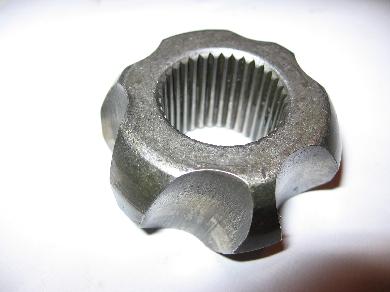Gearbox Clutch CVs CV joints repair
Hacksawbob the CV boot maybe held on with either 8mm 12 point internal spline, aka CV Joint tool aka triple square. OR 6mm hex/allen headed bolts, and maybe a mixture of the two! make sure you use the right tool for the job as these are a pig to remove if rounded common sense says replace them if they look iffy as next time they wont come off so easy and you will know the pain of using mole grips in confined spaces.
Click to see more information on Busgoons
HarryMann: That's all very good stuff Thomas, and great photos too!
Now, I can't answer the question I'm raising without getting out all me greasy manuals and its late, but apart from aligning the large and small sticky out bits, there is supposed to be a right and a wrong way around - axially.
That is, the faces of the outer and inner races have chamfers on them, different depth chamfers each end and some makes have other markings.
Qu. Which way around do all these bits go, and does it matter?
Bentley (and other US articles) makes a big deal about this, and not only which way they go outer to inner, but then which side faces the shaft when installed... all highly friggin confusing I thought, especially as a new GKN one seemed not to agree, chamferwise, with aforesaid dictums. Having played Rubik's cube with it for quite long enough (pre-greasing up being the best time Idea ), settled for the way that it seemed to offer least resistance and jamming up at large angles. As for putting on the truck, think the circlip goes the least chamfered side of the inner race.
Will dig out the manuals unless soemone knows the 'real way', 'right way' or indeed that it doesn't matter a jot for some makes, that it does for OEM joints, or vice versa... (I'm sure that's enough options Rolling Eyes )
90gms of the black stuff per joint? Just stuffing it inside the boot no good - roughly half from each side and really work into the cage. When they're just starting to clunk a bit, to give them another lease of life, or just 'cos you fancy it, squeeze the filthy boot around to work the grease back into the joint - silence - for a while. Clunking rear CVJs can upset smooth changing in lower gears, and put additional shock loads through the diff too.
A full service is: wash off and degrease, clean off all traces inspect, decide, significant track pitting/ galling a no-no, just wear but smooth tracks - OK if you're a tight-wad Reassemble - 'tis fun, honest - refit, regrease.
HarryMann: Yup, I was led to believe that articulation angle is compromised by assembling the wrong way around.
Grease: ETKA says repair kits include 90g (14" rear) and 120g (16" rear) joints I can get all 90g in, and again, led to believe that it's a good idea to put it all in. GSF do a big pot of 'medium' MOS2 cheap, but reckon they'd give you another sachet if asked nicely. If it was a repair kit, maybe 50g is meant not to service, but to top-up - or meant to have two sachets in - one for each side of joint. As with wheel bearings, perhaps never fill cavity 100% (overheat, melty grease) but that would be as good as impossible with a booted joint. Release trapped air through boot sleeve before crimping up tight, but don't leave boot crushed,
SyncroSam: Clive, Is this the difference in chamfer you are referring to?
Top pic smoother edge, bottom pic sharper edge) - I thought sharp edge was driveshaft end as in goes on shaft first, but i probably wrong
TD: Very interesting and great pictures, but I just throw them away when they knock and buy new ones, they are a cheap item compared to many things and outers last 70K +, inners much longer. They are the dirtiest, foulest things to take apart, even paraffin has a job to clean them. Still, makes a great hobby!
HarryMann: Can't say I disagree, just make sure they go in the metal skip, for recylcing or make-weights for your steel scrap!
Flibbertigibbet: but I would like to point out to the more ignorant amongst us what is sounds like is they need changing....ready -
Like a clucking chicken .....!!!!

